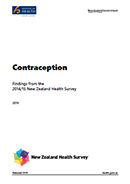Published online:
15 November 2019

This report describes types of contraception used by women or their male partner, among those who had had vaginal sex in the four weeks preceding the survey (referred to as ‘sexually active’ in this report).
Use our Sexual and Reproductive Health Data Explorer to see the results from the 2014/15 Health Survey.
If you have any queries please email [email protected].
Overview of key findings
- 83 percent of men and 80 percent of women (aged 16–49 years) who were sexually active used at least one form of contraception.
- 78 percent of sexually active men and 74 percent of sexually active women used a modern method of contraception.
- Sexually active Māori and Pacific adults were less likely to use any contraceptive methods than non-Māori and non-Pacific adults.
- Sexually active adults living in the most socioeconomically deprived neighbourhoods were less likely to use any contraceptive methods than those in the least deprived neighbourhoods.
- 82 percent of sexually active women who were not trying to get pregnant used modern methods of contraception. ‘Modern’ methods of contraception include implants (including Jadelle), vasectomy, IUS (including Mirena), tubal ligation, hysterectomy, IUD, injections (including Depo-Provera), the pill, male condoms, diaphragms, female condoms, spermicides, the morning-after pill and the emergency IUD.
- To account for the use of multiple methods of contraception, use of different contraception methods were analysed after prioritisation based on order of effectiveness. After prioritisation, the most common contraceptive methods used by sexually active women were the pill (23 percent), the male condom (18 percent) and their partner’s vasectomy (10 percent).
- Type of contraceptive used varied by neighbourhood deprivation. After adjustment for age and ethnicity, women in the most deprived neighbourhoods were 6.1 times as likely to rely on injections than those in the least deprived neighbourhoods, and 0.7 times as likely to rely on their partner’s vasectomy.
- 15 percent of women aged 16–24 used some form of long-acting reversible contraception (LARC), a group comprising implants, intrauterine devices (IUDs) and intrauterine systems (IUSs). The equivalent rate for women aged 35–44 was 12 percent.
- A medical centre/general practice was the commonest source of contraception for women at all ages (41 percent).
Go to Sexual and reproductive health to find out what’s being done in this area.
Related publications
- Sexual and Reproductive Health Data Explorer
- First Heterosexual Sex: Findings from the 2014/15 New Zealand Health Survey
- Heterosexual Sexual Behaviour: Findings from the 2014/15 New Zealand Health Survey
- Sexual Orientation: Findings from the 2014/15 New Zealand Health Survey
- Pregnancy Planning: Findings from the 2014/15 New Zealand Health Survey
- Sexually Transmitted Infections: Findings from the 2014/15 New Zealand Health Survey
- Non-volitional Sex: Findings from the 2014/15 New Zealand Health Survey
- Indicator Interpretation Guide 2014/15: Sexual and Reproductive Health Module
- Questionnaires and Content Guide 2014/15: New Zealand Health Survey
- Methodology Report 2014/15: New Zealand Health Survey
- The New Zealand Health Survey Sample Design, Years 1–3 (2011–2013)
